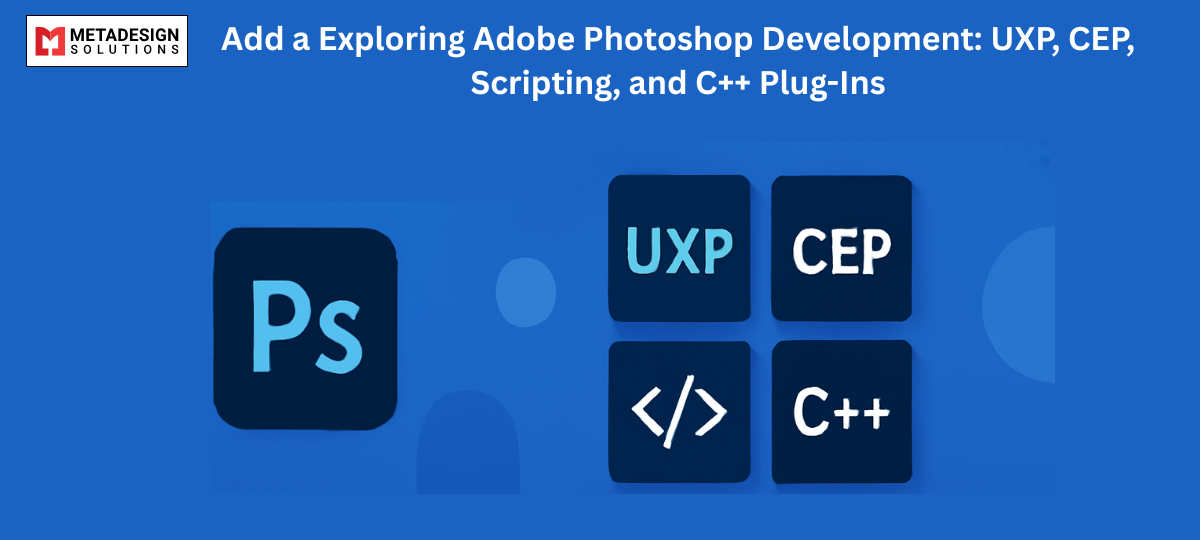If you’re exploring Adobe Photoshop plug-in development, you might wonder about the differences among UXP, CEP, scripting, and C++ plug-ins. Adobe has several plug-in architectures, each with its own capabilities and use cases. Understanding these differences is essential for leveraging the right technology to create custom tools or automate tasks in Photoshop.
This blog will help you differentiate these development approaches and cover Adobe’s recent shift from CEP to UXP, including migration tips for developers. By the end, you’ll have a foundational understanding of Adobe Photoshop’s plug-in landscape.
Understanding UXP, CEP, Scripting, and C++ Plug-Ins
1. UXP (Unified Extensibility Platform)
UXP is Adobe’s latest extension platform, designed as a modern, lightweight, and secure solution for plug-in development. UXP leverages JavaScript with a React-like component system, allowing developers to create robust, responsive UI components without compromising performance. Adobe is migrating from CEP (Common Extensibility Platform) to UXP, positioning it as the future standard for developing cross-platform plug-ins for Adobe applications.
Benefits of UXP:
- Improved Performance: UXP is optimized for performance, running natively and integrating more efficiently with Photoshop than CEP extensions.
- Enhanced Security: UXP extensions are sandboxed and isolated, providing a secure environment that minimizes the risk of interference between plug-ins.
- Simplified UI Development: UXP supports a rich UI framework similar to React, making UI creation smoother and more modern.
- Cross-Compatibility: UXP extensions work consistently across different Adobe apps, supporting a unified plug-in experience.
Here’s a basic UXP example that creates a button in Photoshop:
const { core } = require("photoshop");
document.getElementById("btn-click-me").addEventListener("click", async () => {
const activeDoc = app.activeDocument;
const layer = activeDoc.activeLayers[0];
await layer.delete();
});
2. CEP (Common Extensibility Platform)
CEP is the older Adobe extension platform, primarily based on HTML5, CSS, and JavaScript. It uses Chromium Embedded Framework (CEF) to render plug-in UIs, supporting a wider range of Adobe applications like Photoshop, Illustrator, and InDesign. However, with its reliance on CEF, CEP suffers from performance bottlenecks and compatibility issues with future versions.
Adobe has phased out CEP in favor of UXP to deliver a faster, more secure experience.
Why Adobe is Switching from CEP to UXP:
- Performance Gains: CEP extensions can slow down Adobe applications, while UXP’s streamlined architecture provides a more efficient runtime.
- Security Enhancements: UXP’s sandboxed approach reduces the risk of vulnerabilities that can arise in the less isolated environment of CEP.
- Modern Development Practices: UXP’s compatibility with modern JavaScript features and React-based UI makes development faster and more accessible to a broader range of developers.
Migrating from CEP to UXP
For developers currently using CEP, Adobe offers migration resources to assist with transitioning to UXP. Here are some key steps:
- Rewrite HTML/CSS UI Components in React: UXP’s UI framework is based on React, which requires updating your existing HTML/CSS components.
- Refactor JavaScript Code: UXP supports modern JavaScript and ES6+ syntax, so you can update older JavaScript to a cleaner, more concise format.
- Replace CEP’s
CSInterfaceAPI Calls: UXP has its own APIs that replace theCSInterfaceused in CEP, so migrating requires replacing old API calls with UXP equivalents.
Adobe offers a migration guide to help developers adjust to the new platform.
3. Scripting in Photoshop
Scripting in Photoshop allows for automating tasks without the need for creating a UI. Adobe Photoshop supports JavaScript (ExtendScript), VBScript, and AppleScript, giving developers a range of options based on their operating system and preference. Scripts run directly within Photoshop, making it an ideal choice for automation tasks like batch processing, image adjustments, or document management.
Capabilities of Photoshop Scripting:
- Automation: Scripts can perform repetitive tasks like resizing, cropping, or applying filters, saving hours of manual work.
- Batch Processing: Automate tasks across multiple files, like converting formats or adding watermarks.
- File Manipulation: Control Photoshop documents, layers, paths, channels, and more.
Here’s a sample JavaScript (ExtendScript) script that adds a new layer with specific text in Photoshop:
var doc = app.activeDocument;
var newLayer = doc.artLayers.add();
newLayer.kind = LayerKind.TEXT;
newLayer.textItem.contents = "Hello, Photoshop!";
newLayer.textItem.position = [100, 100];
4. C++ Plug-Ins
For more advanced, performance-driven tasks, Adobe offers C++ plug-ins. These are typically used for computationally intensive operations or to extend Photoshop’s core functionalities at a deeper level. C++ plug-ins interact directly with Photoshop’s API and are suitable for tasks like processing RAW images, creating filters, or manipulating pixel data.
Use Cases for C++ Plug-Ins:
- Custom Filters and Effects: Process image data on a per-pixel basis to create new effects or filters.
- Advanced Image Manipulation: Implement features that require low-level access to image layers and pixel manipulation.
C++ plug-ins are compiled into binary files, making them platform-dependent, so developers need to manage separate builds for Windows and MacOS.
Migration Tips for Developers Transitioning from CEP to UXP
Migrating from CEP to UXP might feel daunting, but following these guidelines can simplify the process:
- Set Up Your Development Environment: Adobe offers developer tools and sample projects to help set up your environment for UXP.
- Refactor Your Code: UXP’s API differs significantly from CEP’s. Update your code to use UXP’s API methods for interacting with Photoshop’s DOM.
- Embrace Modern JavaScript: UXP fully supports ES6+ syntax, which means you can leverage modern JavaScript features like async/await, destructuring, and modules.
- Recreate Your UI with UXP’s Component Library: UXP’s component library provides UI elements like buttons, sliders, and text fields, streamlining the UI creation process.
How to Get Started with Photoshop Plug-In Development
Whether you’re aiming to automate tasks, create new UI tools, or extend Photoshop’s capabilities, understanding the right platform is crucial. UXP and scripting are often the best starting points for automating tasks or adding simple UI elements, while C++ plug-ins are ideal for high-performance needs.
If you’re looking for expert support or consultation on Adobe Photoshop plug-in development, reach out to our team at sales@metadesignsolutions.com. At MetaDesign Solutions, we have extensive experience with UXP, CEP, scripting, and C++ plug-in development. Let us help bring your Adobe Photoshop plug-in ideas to life!
Take Your Photoshop Tools Further
Schedule a consultation with MetaDesign Solutions to build next-gen Photoshop add-ons, automate tasks with scripting, or migrate from CEP to UXP.
Related Keyphrase:
#AdobePhotoshop #UXP #CEP #PhotoshopScripting #CplusplusPlugins #AdobeDevelopment #PhotoshopPlugins #PluginDevelopment #TechInDesign #AdobePhotoshopDevelopmentCompany #AdobePhotoshopDevelopmentServices #HireAdobePhotoshopDevelopers #CreativeTools #AdobeDevelopmentServices #SoftwareDevelopment #DesignAutomation #TechInnovation #AdobeTech #PluginDevelopment #CplusplusDevelopment #CreativeSuite #PhotoshopDevelopment #UXDesign #PhotoshopCustomization #CreativeCommunity #TechSolutions #DigitalDesign



